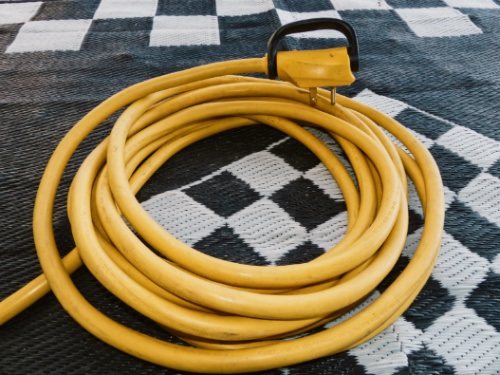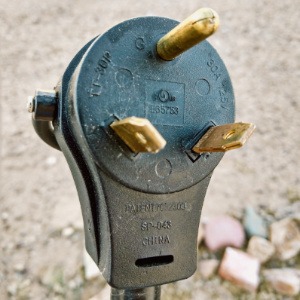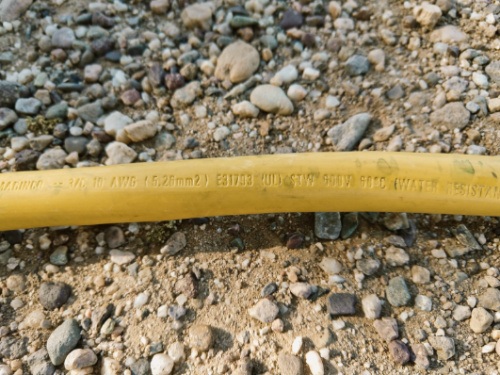Need to know what size wire for welder extension cord safety and performance?
There’s no doubt that a lightweight, undersized cord can derail your welding project. With long runs, extra resistance can lead to cord-melting heat, shorts, and even fire.
At a minimum, you can expect the voltage to drop, causing poor weld performance and tripped breakers.
Avoid these issues with this welder extension cord chart. You’ll quickly learn what size wire can carry the load for your welder—at the extension cord length you need.

Welder Extension Cord Size Chart: Wire Gauge vs Length
Welding machines require their rated input voltage to maintain output welding amperage and duty cycles. So size your extension cord wire for minimum voltage drop.
For efficient performance, the NFPA 70, National Electrical Code (NEC) 210.19(A)(Note 3) recommends branch circuits be sized to prevent voltage drops exceeding 3 percent.
This chart shows what gauge wire (AWG) will carry a full current load with less than a 3% voltage drop.
| Input Power Supply | Extension Cord Length | ||||
|---|---|---|---|---|---|
| Amperage | Voltage | 25 ft. | 50 ft. | 75 ft. | 100 ft. |
| 15A | 120V | 12 AWG | 12 AWG | 10 AWG | 8 AWG |
| 20A | 120V | 10 AWG | 10 AWG | 8 AWG | 8 AWG |
| 30A | 120 / 240V | 8 AWG | 8 AWG | 8 AWG | 6 AWG |
| 40A | 240V | 6 AWG | 6 AWG | 6 AWG | 6 AWG |
| 50A | 240V | 6 AWG | 6 AWG | 6 AWG | 6 AWG |
Assumptions to Size Welder Extension Cord Length
To calculate a maximum 3% voltage drop with single-phase, 120/240-volt power, I used a power factor of 1, at an ambient temperature of 78-86℉.
Basic voltage calculators don’t account for the unique use and properties of extension cords. For accurate results, we need to make additional adjustments.
Because most pre-made cords use copper wire conductors with 60℃ insulation, I used this in the calculations.
With a thick protective covering, heavy-duty extension cords build more heat than typical conduit installs, so I factored this in.
Finally, I verified the results with an ampacity table to ensure that each conductor can continuously carry the maximum current without exceeding its temperature rating.
Sources: NFPA 70, National Electrical Code, Table 310.15(B)(16-17), NEC Chapter 9, Table 9

Welder Extension Cord Options
With a little care, a heavy-duty extension cord can last for decades.
While the above chart gives you the minimum gauge wire to use for a specific amperage and distance, you can go with a heavier cord. You’ll get less voltage drop, and can upgrade your welder without needing to buy another cord.
Pre-made extension cords
For 120V welders, this 10-gauge cord handles 20-amps out to 50 feet.
And, here’s a good-quality 25-foot extension cord for small 240V welders.
With cable jackets having a “W” code rating, both are suitable for outdoor use. But the “T” designation on their jackets shows a thermoplastic (PVC) cover. While durable, a PVC cover loses flexibility in cold temperatures and degrades under high heat.
Pre-made heavy-duty 6-gauge cords are difficult to find. But owners of 40 to 50-amp welders have another option—build your own welder extension cord.
[Update: This 50-foot welder extension cord is true 50A, 6-gauge wire with premium SOOW jacketing, and molded plugs for what you’d pay for the wire alone.]
Build an extension cord with wire sized to your specs
Use SOOW cable and connectors to make a true heavy-duty welding extension cord. Not only can you get this in 6-gauge wire with 90℃ insulation, but it’s enclosed in a premium thermoset rubber jacket.
You’ll see this cord on top-of-the-line power tools. It’s durable, weather-resistant, and oil-resistant (both the jacket and internal wires).
What I like, though, is how easy this cord is to handle. Even in sub-zero temperatures, this cord doesn’t become stiff or take a set, and always lies flat on the floor.
Why Understanding Wire Gauge Size and Amps Matters
Welders must transform low-amp input power into the high-current output power needed for welding. A typical 110V MIG welder requires 20 amps of input power to generate its 140-amp peak output. That’s a 7x increase in amperage and shows why welders need every bit of voltage available.
There’s a direct correlation between cable length, amperage, and wire gauges.
A larger gauge (diameter) wire carries the current for a longer distance without voltage-robbing resistance and heat. A correctly sized extension cord allows your welder to operate properly without tripping circuit breakers.

Some Helpful Tips for Extension Cord Success
Do:
- Understand how much current your welder draws
- Size the circuit breaker to the welder
- Use building wire and an outlet sized to the breaker that protects it
- Size the extension wire gauge to the length and current draw required (or larger, but never less than the breaker)
- Keep your extension cord as short as possible, with the largest gauge practical
- Unroll extension cords to prevent heat buildup
Don’t:
- Use Romex or other solid wire as a portable extension cord
- Repeated coiling/uncoiling will damage solid wire
- Covering is not durable enough and is easily damaged by spatter
- Use a cord with less amperage rating (for its length) than your welder or circuit
- Keep extension cords coiled during use
- Use any cord lacking a ground plug
- Run more than one high-current tool on a cord or circuit at the same time
- Use a long extension cable if a shorter one is available
The big picture
Our chart shows what size wire your welder needs by extension cord distance. Follow the recommendations to make sure your welder runs safely and efficiently, without interruptions from tripped breakers.
A good 10-gauge cord protects 120V welders to 50 feet. Use SOOW cable to make your own cord for large welders and long runs.
Remember, a good extension cord can last many years—avoid the cheap and light-duty stuff!

